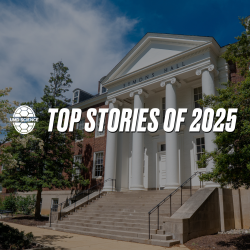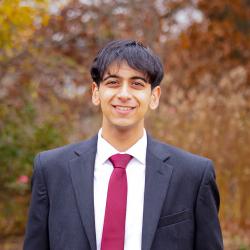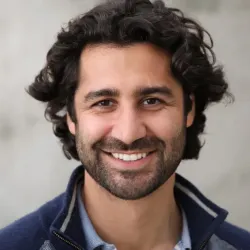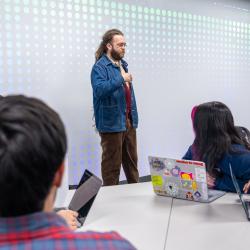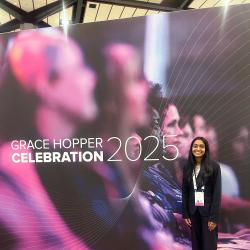Translating the Power of Artificial Intelligence
At Google, Sweta Agrawal (M.S. ’20, Ph.D. ’23, computer science) and Eleftheria Briakou (M.S. ’20, Ph.D. ’23, computer science) are working on the cutting edge of artificial intelligence, advancing Google Translate.
In 2018, Sweta Agrawal left India and Eleftheria Briakou left Greece to begin their Ph.D.s in computer science at the University of Maryland. Anxious to chase their dreams of a future in tech, they never imagined how their paths would cross on the road ahead.
Agrawal (M.S. ’20, Ph.D. ’23, computer science) set her sights on earning a Ph.D. with a specific goal in mind.
“At the time, I really wanted to be a research scientist at Google,” she said. “It was just an insanely huge thing that I was making this decision, traveling all this distance to do something, and none of my family knew even what it meant or what it was supposed to do for my career. I just took a leap of faith.”

Briakou (M.S. ’20, Ph.D. ’23, computer science) majored in electrical and computer engineering during college, but she couldn’t help feeling that something was missing. She found it at UMD.
“For me, applying for a Ph.D. was a way to keep exploring and keep my possibilities open,” she said. “But the happy surprise was that during my Ph.D. at Maryland, I got incredibly passionate about what they called machine translation—using computer software to translate text from one language to another.”
At UMD, Briakou and Agrawal took on problem-solving research that pushed the boundaries of natural language processing and machine translation and building a life-changing friendship along the way.
Now, they’re working on the cutting edge of artificial intelligence (AI) at Google, leveraging the skill sets they developed at UMD to advance the company’s AI language application, Google Translate. Using advanced machine learning, the app translates text, speech and images in real-time, communicating in more than 200 languages.
“Every single day it surprises me—the models we’re working with, the things that they can do, and how they can make things easier and boost productivity,” Agrawal explained. “It’s all there, but there is so much farther to go in terms of understanding translation capabilities and where they come from. As AI researchers, I think we’re still at the forefront, but we need to know much more.”
Bonding over classwork, computers and boundless curiosity
As graduate students at UMD, it didn’t take long for Agrawal and Briakou to connect. Sharing the same interests, the same advisor, Computer Science Associate Professor Marine Carpuat, and many of the same classes early on, the two young women bonded over classwork, computer technology and their boundless curiosity.
“We are very invested in what we do,” Briakou said. “What would be a quick thirty-minute call with anyone else often turns into a three-hour deep dive for Sweta and me.”
“Once we started talking, it was very easy to share most things work or otherwise,” Agrawal recalled. “I heavily relied on Eleftheria’s feedback on almost every research project I was doing, and I think that made a huge difference. When there’s a person you look up to and that person is a good friend, you keep growing with them and learning from them.”
In their Ph.D. research, Agrawal and Briakou explored strategies to make translation more accurate and intuitive, building better models across diverse languages and developing adaptable multilingual language generation models.
“I think it was helpful that both of us were bilingual, which gave us a real insight into the problem,” Briakou noted. “During my Ph.D. I focused a lot on identifying the small meaning differences that can naturally occur in translations to reflect cultural nuances and different communication goals.”
“My work actually went in a complementary direction,” Agrawal added. “I was working towards a more controllable machine translation, intentionally changing the meaning to fit the specific audience. In other words, how do we translate the same text differently to better suit, let’s say, a third-grade student, versus a native adult speaker, versus a non-native speaker?”
Beyond research, their experiences provided a strong foundation for the future.
“What my Ph.D. at Maryland did for me was not just learning about machine translation specifically or large language models,” Agrawal reflected. “I think what it really taught me is, how do you think about research? How do you think about problems, and how do you approach them? And these are the most fundamental building blocks.”
Real-world internships and the power of AI
By 2022, the release of ChatGPT was accelerating interest in AI technology that could interact rapidly with users through text and speech. Advances in large language models (LLMs) continued to expand the possibilities for natural language processing, and for Briakou and Agrawal, real-world internships underscored the growing power of AI.
“One year before we graduated, I was doing an internship at Google, and Sweta was at Meta. The year before, I was at Meta and she was at Google, and I think that’s when we both kind of switched to LLMs,” Briakou explained. “I think that for me was the point where I realized how much LLMs were really changing things.”
“Suddenly, everyone was invested in LLMs,” Agrawal explained. “The technology was there, people were using it, and it was exciting to know that there was just so much potential, so much more that you can do with it.”
Briakou joined Google as a full-time research scientist in 2023. Agrawal opted for a postdoc in Portugal before joining Google a year later.
Now, working together at Google, the two friends are developing AI translation tools that allow millions of people to communicate across hundreds of languages every day.
“Using reasoning with large language models to do translation is something that wasn’t possible even two years ago,” Agrawal explained. “At this point, it’s about really tapping into what capabilities are there within these models for both translation and multilinguality. What can we do, and what are the caveats that come with it?”
“I hope we can continue to make progress,” Briakou said, “to develop better systems, better products and research that can help more people and make these translations better for everyone.”
Agrawal and Briakou couldn’t be more grateful to UMD for bringing them together.
“It’s crazy because I know how rare this can be,” Briakou said. “And I think it makes so much difference when you find a connection like this because even beyond friendship, there’s the respect I have for Sweta as a researcher and as someone who is doing good work, and that’s a great foundation because you know you’re learning a lot and growing together.”
“For me, this has been the best part of all,” Agrawal said. “When you’re able to find an advisor, a friend and now a coworker in the same person, it’s amazing—just 100% incredible.”



